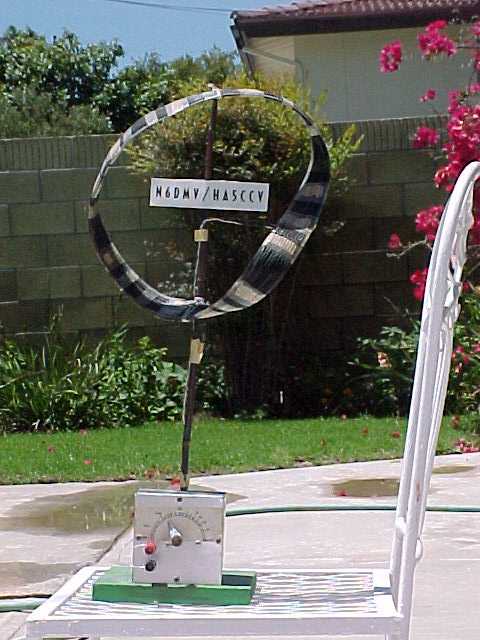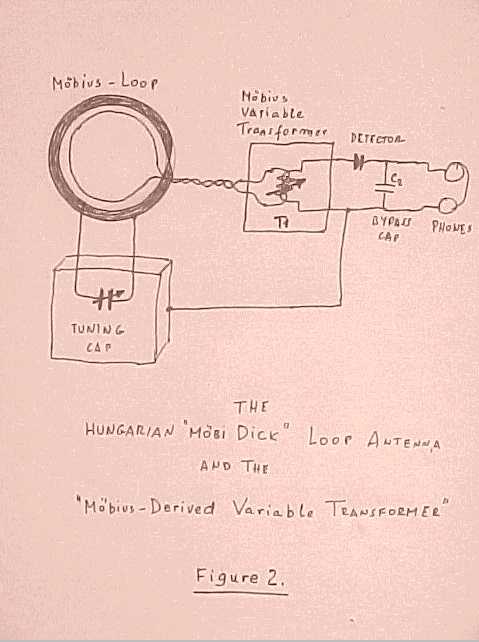

THE TEXT:
The Hungarian "Möbi Dick" Crystal Set.***
[Note: the "ö" can be produced by keys (alt+148)]
I have a 'Real Möbius' loop I built about 12 years ago and showed it to numerous people – college physics students, electronic engineers, physicists, etc. Most of them got a good laugh out of it, but some of them became quite serious about the subject and asked for more details. I told them as an introduction, that I wanted to make an antenna for transmitter direction finding which requires a cardiodid radiation pattern. I hoped to accomplish this automatically with the M-loop antenna, without a 'sense' antenna. I asked them to describe the principle behind this novel design. Some actually started to calculate on paper. Figure1 photograph shows the materialization of this loop.
This is how I did it:
First I cut a 2 inch wide plastic strip long enough to make a 14 inch diameter cylinder. 20 turns of hook-up wire gave a coverage for the AM broadcast band with a 420 picofarad variable air capacitor. The metal box on Figure 1 houses the capacitor. Q-factor=125. The loop worked and I could hear 2 stations inside the house with a cat whisker galena detector, no outside antenna connected. Then I unwound the wire, made an M-strip out of the plastic - by rotating one end 180 degrees and glued them together again - and rewound the same wire. It was tricky because half of the turns are on the inside of the loop. Application of adhesive tape solved the problem. Also included a 1-turn coupling winding [twisted pair] for the detector and phones.
Corollary to Paul's loop is the "Paul's Infinite-Step, Möbius-Derived Variable Transformer" which may be adopted with some modifications to crystal sets and other equipment as variable-load matching or power control devices between the detector and the mechanical transducer (ear phones, speaker, etc.) for maximum power transfer, or loudness. The scheme is shown in Figure 2.
This Möbius-Derived novel transformer's operating principle is described below in terms of the original M-strip as follows - first on paper for the "proof of principle", then with wires:
Cut a piece of paper of approximately 18-24 inches long and ~2 inches wide. Twist one end of the strip 180 degrees and glue the ends together. With a pencil, draw a line on the center line of the strip by pulling the paper along under the pencil. The line will return to the beginning, proving that the strip has only one surface!
Now, cut the tape along the pencil line, but first try to imagine, what will result. Surprise – you will get a loop twice the size with a full twist. Cut the tape again along the strip – guess first the expected results. A loop 3 or 4 times as big? Surprise again: you will end up with 2 intertwined loops of the same size! So far – except for a very few - who did knew about the M-strip beforehand, nobody was able to predict the outcome of the cuttings.
For argument's sake, substitute the paper with insulated conductors – copper wires. Stretch one of the loops and you will find that the second wire makes 2 turns over the first one. If you would cut the first wire [primary winding] and impress, let say 1 volt on it, by cutting the second [secondary winding] wire and measuring the voltage across it would show 2/1=2 volts! – a step-up transformer. Now stretch the second wire, leaving the power source connected to the primary. Likewise, the first wire will surround the second one twice, hence you end up with a step-down transformer with a turn ratio of 1/2=0.5 volts! All in all, the two limiting cases results in a four-to-one [2/0.5=4] continuously variable transformer! By stretching both windings equally, you have a 1:1 isolation transformer. As you see, it is quite versatile! Of course lot of the flux would escape due to the lack of an iron core and the said scene is mostly theoretical until somebody figures out how to do it more efficiently. The higher the frequency, the higher the efficiency.
What happens now, if you carry the tape-cutting one step further, cutting both loops in half along the centerlines. Can you guess what would you get? The result: 4 intertwined loops with 2 turns around each other! Any time you cut now the strips in half, you would multiply the number of windings by 2. This means that you can make a transformer with multiple windings out of one loop! One could ask, of course, why not just wind two turns of wire over another wire? You can, but then nobody would call it 'Paul's M-derived Continuously Variable 1:4 or 4:1 Transformer". Professor M. gave me the idea.
'Advantages' of Paul's Möbius-Derived Loop Antenna
In case one wonders who M. was, here it is - quote:
"August Ferdinand Möbius (1790-1868) German astronomer, analytical mathematician, publisher of several scientific papers and books, university professor and topology expert invented a strip named after him. The strip is made into a closed loop, and has only one surface. "
*** The 'ö' is pronounced as 'ea' in the word 'earl'.
And now the truth:
--- to be withheld from the audience first until the quiz results are in ---
The M-coil can not work as a regular loop antenna, of course, because of the magnetic flux reversal, cancellation within the plane of the loop. Any detectable 'antenna effect' delivering some energy from the air is due either of the capacitive coupling (to the transmitter or to any metal object submerged in the RF field nearby acting as a secondary radiator) and/or by the pick-up by the uncancelled magnetic fields (due to the finite physical dimensions and asymmetries) of the coil penetrated by the transmitter power.
In trying to resonate the M-loop, I ended up with a flat resonance curve at about 18 MHz – the indication of the flux cancellation. The 18 MHz is essentially the self-resonance of the coupling turn damped by the loop itself. As a trick, I built an iron core coil series with the loop in the box. This way I could show a resonance (the M-loop is essentially an RF short circuit) by tuning the capacitor. I asked the onlookers to try to guess what is in the box. Nobody could. I must have had an unimaginative audience.

